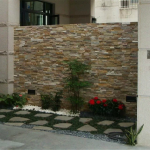Introduction:

Cultured stone siding, also known as manufactured stone veneer, is a popular choice for homeowners looking to enhance the aesthetic appeal and durability of their homes. This versatile building material offers the look and feel of natural stone at a more affordable price point, making it an attractive option for both new construction and renovation projects. In this comprehensive guide, we will explore the beauty and benefits of cultured stone siding, including its design options, installation process, maintenance requirements, and environmental impact.
History and Evolution of Cultured Stone Siding:
Cultured stone siding has a rich history that dates back to the mid-20th century when it was first developed as a cost-effective alternative to natural stone. The early versions of cultured stone were created using a combination of cement, aggregates, and iron oxides to mimic the appearance of various types of stone, such as limestone, granite, and slate. Over the years, advancements in technology and manufacturing processes have led to the development of more realistic and durable cultured stone products that closely resemble the texture, color, and shape of natural stone.
Design Options and Versatility:
One of the key advantages of cultured stone siding is its versatility in terms of design options. Today's manufacturers offer a wide range of colors, textures, shapes, and sizes to suit the aesthetic preferences of homeowners and architects. Whether you prefer the rustic charm of fieldstone, the classic elegance of limestone, or the modern appeal of stacked stone, there is a cultured stone product available to complement your home's architectural style and design.
In addition to the variety of stone styles, cultured stone siding can also be customized to create unique patterns and arrangements. From https://www.fs-slate.com/what-is-stone-veneer-and-why-should-you-choose/ -stack installations to more intricate designs like herringbone or basket weave, the possibilities are endless when it comes to creating a one-of-a-kind look for your home's exterior. With the help of skilled craftsmen and designers, you can achieve a personalized and visually striking facade that enhances the curb appeal of your property.
Installation Process and Considerations:
Installing cultured stone siding requires a combination of skill, precision, and attention to detail to ensure a professional and long-lasting result. The process typically involves several steps, starting with the preparation of the substrate and the application of a weather-resistant barrier to protect against moisture intrusion. Next, the cultured stone units are individually positioned and secured using mortar or adhesive, depending on the manufacturer's recommendations.
It is important to note that proper installation techniques are crucial to the performance and longevity of cultured stone siding. Hiring a qualified contractor with experience in working with manufactured stone products is highly recommended to ensure that the installation is done correctly and up to industry standards. Additionally, following the manufacturer's guidelines for handling, storage, and maintenance will help prevent issues such as cracking, discoloration, or water damage over time.
Maintenance and Care:
One of the appealing aspects of cultured stone siding is its low-maintenance requirements compared to natural stone. While natural stone may require regular sealing, cleaning, and repairs to maintain its appearance and structural integrity, cultured stone is designed to be more resistant to staining, fading, and weathering. Routine maintenance tasks for cultured stone siding typically include periodic cleaning with a mild detergent and water, as well as inspecting for any signs of damage or wear.
In addition to general upkeep, it is important to address any specific maintenance needs based on the type of cultured stone product installed on your home. For example, textured or rough-hewn finishes may require more frequent cleaning to prevent dirt and debris buildup, while smooth surfaces may benefit from occasional sealing to enhance their water resistance and color retention. Consulting with the manufacturer or a professional contractor can help you develop a tailored maintenance plan that preserves the beauty and performance of your cultured stone siding for years to come.
Environmental Impact and Sustainability:
As sustainability and environmental consciousness become increasingly important in the construction industry, the choice of building materials plays a significant role in reducing the carbon footprint of residential and commercial projects. Cultured stone siding offers several environmental benefits compared to natural stone, including lower energy consumption during production, reduced waste generation, and decreased transportation costs due to its lighter weight.
Many cultured stone manufacturers prioritize sustainability by sourcing materials locally, using recycled aggregates, and implementing eco-friendly manufacturing practices that minimize resource consumption and emissions. By choosing cultured stone siding for your home, you can contribute to a more sustainable building industry and create a greener living environment for future generations.
Conclusion:
Cultured stone siding is a versatile and attractive option for homeowners seeking the beauty and durability of natural stone without the high cost and maintenance requirements. With a wide range of design options, easy installation process, minimal maintenance needs, and positive environmental impact, cultured stone siding has become a popular choice for residential and commercial projects alike. Whether you are renovating your existing home or building a new property, consider the many benefits of cultured stone siding to enhance the curb appeal and longevity of your investment.
